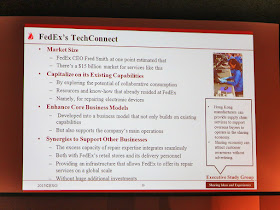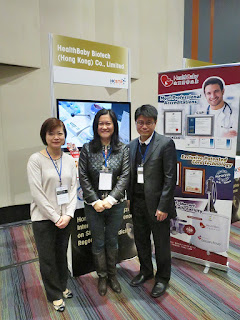Seminar x57, Training/Workshop x10 , Visit x7, Conference/Symposium/Forum x19,
Arrange visit to HKSTP x2, Invited Speaking x6, Teaching course x1 and Professional Gathering x25.
ASQ Influential Voice article x11
(Photo: My last lecture for BCH 6116 because of whole MSc course rearrangement)
Seminar:
(YYYYMMDD)
20150107: ESG Seminar – e-Business Strategy
20150116: HKSQ & ISI Seminar of Innovative Model - iTQI
20150121: HKSQ Seminar on Assuring Food Quality and Safety in the UK Food Industry
20150124: HKSTP & HKSQ Seminar on System Approach to Innovative Management
20150129: HKSTP & Alibaba B2B Export e-Commerce Business Seminar
20150131: ISI Innovation Sharing Seminar & Summer Networking 2015
20150202: An Evening with Jack Ma (馬雲與青年有約)
20150205: HKCTC & HKAS Seminar on Greenhouse Gas Validation & Verification
20150211: OUHK Technical Seminar on Methodology and Technology in Microbiology Testing
20150213: ESG Seminar – How Google Uses Its Culture to Motivate Post-80s Generation
20150306: SCL Talk on Photometric and Radiometric Measurement
20150309: HKCTC & HKAS Seminar on Healthy Life and Food Testing & Certification
20150310: PMI Seminar on DFSS to Project Management
20150313: ICT Seminar for Innovation and Technology Development
20150317: HKCTC & HKAS Seminar on Gold Testing & Gemstone Authentication
20150319: IIPCC-HK Seminar “OEM to ISP (Integrated Service Franchiser) Transformation”
20150320: HKSTP IP Seminar – Win the Patent Game
20150410: PolyU Public Seminar on Innovation and Patent
20150414: CityU Omni-Channel Retailing Innovation Seminar
20150428: ITC Enterprise Support Scheme (ESS) Briefing Session
20150513: Lab Test One in One Click Launching Ceremony cum Cutting Edge Testing Technologies Seminar
20150529: Seminar Celebrating the WMD, the WAD and the WSD 2015
20150608: Seminar on Enhancing Brands for Overseas Markets
20150626: HKSQ Seminar on Food Toxicity using Fish Embryos
20150706: HKCTC & HKAS Seminar on R&D Projects of Medical Testing
20150710: HKQAA Seminar on the Next Generation of Management System Standards (ISO 9001:2015)
20150713: HKCTC Seminar on Professional Integrity in Testing and Certification
20150713: Seminar on Insights and Breakthrough Concepts of TRIZ Systematic Innovation
20150721: CMATCL Seminar on Exploring New Business Opportunity for Proprietary Chinese Medicine (pCm) & Cosmetics Products entering into China
20150731: HKSQ Seminar on ASQ Certification Programs
20150831: HKSQ Seminar on ISO 9001:2015 & ISO 14001:2014 – Executive Overview
20150814: HKSQ Seminar on Strategic Energy Management (ISO 50001)
20150820: HKIE Seminar on Industry 4.0: The 4th Industrial Revolution
20150821: ESG Seminar – Crisis Management on Social Media
20150821: HKSQ Seminar on Big Data & Rapid Systematic Innovation Framework
20150822: HKSQ Seminar on Strategic Management by Policy (SMBP)
20150901: HKSTP Leadership Seminar – The 10 Innate Qualities of a Successful Leader
20150907: CityUES Seminar on “The Rise of China, One Belt and One Road, the China Dream”
20150909: HKSTP TecONE Seminar on Business Model
20150916: CityU Research Seminar on “How to write a Good Grant Application”
20151007: HKSTP TecONE Seminar on Risk Management
20151008: HKAS Seminar on Accreditation Service (AS) System
20151008: HKQAA Hong Kong Registration Ceremony of Recycling Services Pilot Program and Kickoff of Eco-friendly Series
20151009: HKSQ Seminar on Organization Development Study of the Impact of Cultural Factors on Six Sigma Implementation in Southern China
20151016: ESG Seminar – Persuasion Science to Influence Customers and Staff
20151110: HKSTP Design Thinking Seminar on Customer Services
20151113: HKSQ Seminar on Listening to the Voice of the Customer
20151119: HKSTP Seminar – Formulating Strategy for Sustainable Growth
20151120: HKSQ Seminar on ISO 9001, ISO 14001 & ISO/CD 45001 New Requirements & Implementation
20151123: HKSQ Seminar on the Impact of ISO 9001:2015 on Outsourcing
20151201: HKCTC Seminar on Quality Management and Quality Assurance
20151203: HKQAA Seminar on “A New Era of Management System Standard - ISO 9001:2015”
20151207: HKSTP Design Thinking Seminar on Management
20151221: ESG Seminar – Innovation Strategy on Sharing Economy
20151230: CMA Live Your Dream Seminar on Testing and Certification for Better Business Development
Training / Workshop:
20150203: Innovative Thinking Workshop – Thinkertoys
20150207: HKSQ & ISI Workshop of Innovative Total Quality Improvement (iTQI)
20150411: HKSQ Pharmaceutical Good Manufacturing Practices (GMP) Workshop
20150512: The 2nd Workshop on Advanced Methods in Food Microbiology and Chemistry
20150518-19&25-26: MA TRIZ Certification Level 2 Training
20150622: HKQAA CSR Strategic Planning and Reporting Workshop
20150714: Team Synergy and Creative Problem Solving Workshop
20151205: HKSTP DIY Marketing Workshop – Marketing Research
20151209-10: HKQAA ISO9001:2015 QMS Lead Auditor Transition Training Course
20151212: HKSQ Iberico Ham and Wine Pairing Workshop
Visit:
20150228: HKSQ QoL Walking Tour to Tai Ping Shan Medical
20150404: Visit to EWHA Womans University 2015
20150407: Visit to JEJU National University 2015
20150508: HKSQ Technical Visit to HKTDC
20150812: Visit to Hong Kong Precious Metals Assay Centre under CGSE
20150922: HKSQ pre-ANQ Congress Visit to Pharmaceutical Co., Ltd.
20151106: The 3rd Chinese Quality Forum – Day 3 Work Meeting & Visit TusPark
Conference / Symposium / Forum:
20150113: CityU Mobile Technology Festival 2015 (12 – 21 January 2015)
20150114: SME Cloud Promotion Campaign (HKSTP)
20150312: CityU Matchmaking Symposium for Innovation Projects
20150413: CAE-HKAES Joint Summit on Innovation and Technology Industry in Hong Kong and the PRD (13-14 Apr 2015)
20150416: IoT Symposium 2015
20150505: 2015 World Conference on Quality and Improvement (Albert & Fugee participated)
20150529: HKQAA Symposium 2015
20150624: HKSTP APAC Innovation Summit 2015 - Robotic
20150703: HKSTP Entrepreneurship Symposium 2015
20150715-17: The 6th International Conference on Systematic Innovation - ICSI 2015
20150721: The 1st Forum on Sustainable Development in Higher Education
20150923-24: ANQ Congress 2015 Taipei
20151017: CityU EngD Open Forum – Innovation and Entrepreneurship
20151025-27: IAQ World Quality Forum 2015, Hungary – Welcome Cocktail
20151104-05: The 15th China Quality Award cum Chinese Quality Forum
20151118: ASTRI Industry and University Consultation Forum 2015
20151125: ITC & HKCTC Conference on ISO 9001:2015
20151206: ASHK 1st Science and Technology Innovation Summit
20151220: HKSTP Hong Kong & Guangzhou International Conference on Stem Cell and Regenerative Medicine
Visit to HKSTP:
20150122: The Gulf Cooperation Council Accreditation Centre and Standardization Organization representatives visit to HKSTPC Laboratories
20151202: The Gulf Cooperation Council Accreditation Centre - Secretary-General Visit to HKSTP Laboratories
Invited Speaking:
20150119: CUHK Guest Lecture for ISO Journey in Science Park Laboratory and HKSQ Membership Drive
20150424: PMI Seminar on QMS based Information Security Management
20150509: MoU Signing Ceremony & Technical Seminar on Testing and Certification 2015
20150619: HKCTC & HKAS Workshop on ISO 27001 ISMS Certification
20150730: Towngas CPD Seminar - Quality & Innovation Management System
20150801: HKQAA Risk Management Experience Sharing Talk
Teach courses in CityU:
1/09/15 to 30/12/15: BCH 6116 "Quality and Environmental Management for Laboratory"
Professional Gathering / Meeting:
20150123: CityU EngD Society AGM Seminar & Dinner 2014
20150203: HKSQ Support Shenzhen Quality City Promotion Association AGM 2015 (Aaron participated)
20150302: Focus Group Meeting for alignment of HKQF & EQF
20150307: CityU Eminence Society – The 3rd Exco Inauguration Ceremony & Annual Dinner 2015
20150314: HKSQ Student Project Competition 2015 – Presentation
20150315: HKFSTA AGM and Spring Dinner 2015
20150416: HKSTP MINGLE Luncheon with Mr. Shih Wing Ching (施永青)
20150425: HKIUR Inauguration Ceremony cum Networking Session
20150428: Dinner with Darrell Mann (Innovation Expert)
20150528: Meeting with CityU President and HeathBaby Group for Potential Collaboration
20150602: HKQF the 6th TIC-ITAC Meeting
20150611: AQBPA Award Ceremony Cum ISSC Annual Dinner 2015
20150710: Ceremony Dinner for the Launch of “Shanghai-Hong Kong Gold Connect”
20150718: HKSQ AGM 2015 and Zero Defect Strategy Seminar
20150804: The 1st Focus Group Meeting on Evaluating Impact of HKQF
20150822: HKSQ Strategy Meeting 2015
20150923: Pre-Chinese Quality Forum (華人品質論壇) Meeting & Dinner 2015
20151012: The 1st Hong Kong Precious Metals Assay Centre Steering Committee Meeting
20151121: CityU EngD Society 10th Anniversary Dinner 2015
20151122: CityU Inauguration of Institute for Advanced Study
20151123: CityU Innopreneurship Ecosystem Launch Ceremony 2015
20151123: ISO/TC 176 Meeting in Hong Kong – Welcome Reception
20151127: HKSQ Dinner with Mr. Juhani Anttila (Finnish Society for Quality)
20151208: HKTIC AGM and Annual Gathering 2015
20151216: Towngas Quality Day 2015
20150203: HKSQ Support Shenzhen Quality City Promotion Association AGM 2015 (Aaron participated)
20150302: Focus Group Meeting for alignment of HKQF & EQF
20150307: CityU Eminence Society – The 3rd Exco Inauguration Ceremony & Annual Dinner 2015
20150314: HKSQ Student Project Competition 2015 – Presentation
20150315: HKFSTA AGM and Spring Dinner 2015
20150416: HKSTP MINGLE Luncheon with Mr. Shih Wing Ching (施永青)
20150425: HKIUR Inauguration Ceremony cum Networking Session
20150428: Dinner with Darrell Mann (Innovation Expert)
20150528: Meeting with CityU President and HeathBaby Group for Potential Collaboration
20150602: HKQF the 6th TIC-ITAC Meeting
20150611: AQBPA Award Ceremony Cum ISSC Annual Dinner 2015
20150710: Ceremony Dinner for the Launch of “Shanghai-Hong Kong Gold Connect”
20150718: HKSQ AGM 2015 and Zero Defect Strategy Seminar
20150804: The 1st Focus Group Meeting on Evaluating Impact of HKQF
20150822: HKSQ Strategy Meeting 2015
20150923: Pre-Chinese Quality Forum (華人品質論壇) Meeting & Dinner 2015
20151012: The 1st Hong Kong Precious Metals Assay Centre Steering Committee Meeting
20151121: CityU EngD Society 10th Anniversary Dinner 2015
20151122: CityU Inauguration of Institute for Advanced Study
20151123: CityU Innopreneurship Ecosystem Launch Ceremony 2015
20151123: ISO/TC 176 Meeting in Hong Kong – Welcome Reception
20151127: HKSQ Dinner with Mr. Juhani Anttila (Finnish Society for Quality)
20151208: HKTIC AGM and Annual Gathering 2015
20151216: Towngas Quality Day 2015


































































